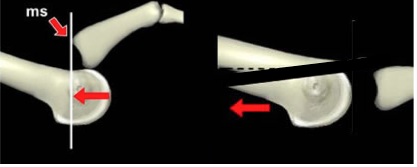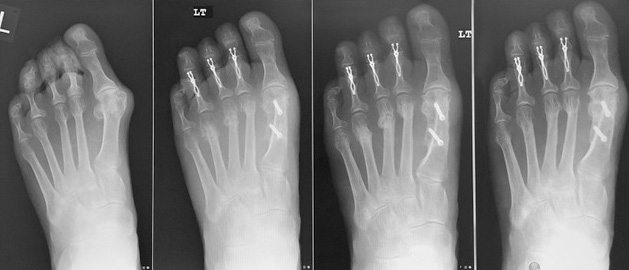Minimally Invasive Metatarsal Osteotomy (DMMO)
This operation is performed for clawing of the toe or for metatarsalgia (pain under the ball of the foot). It involves shortening and elevating the prominent metatarsal using a minimally invasive burr. The procedure is performed using minimally invasive techniques under xray guidance. The skin incision is only 3mm long over the top of the foot. Using xrays to guide the burr, a small oblique section of bone is removed. No fixation is required as all the ligaments are left in place and hold the bones in position.

The surgery is routine, and is performed as a daycase. Following surgery, the foot will be in a thick bandage. You will be able to walk on the foot immediately, but it will naturally be sore. The osteotomy requires protection in a protective post operative shoe for 2-4 weeks.
Risks of surgery
Stiffness & swelling
Initially the foot will be very swollen and needs elevating for 1 week. The swelling will disperse over the following weeks & months but may still be apparent at 6 months. The toe will be stiff but will normally regain its original movement. Physiotherapy will help in the first few weeks.
Infection
There is always a risk of infection with surgery. You will be given 1 dose of intravenous antibiotics during surgery. The best way to reduce your chances of acquiring an infection is to keep the foot elevated for 7 days days. If there is an infection, it normally resolves with a course of oral antibiotics.
Nerve damage
A nerve supplying the side of the toe, lies beneath the incision. This is at risk of damage. Usually it is just bruised and will recover. If the damage is permanent, it will leave a small patch of numbness. This does not normally cause any disability.
Undercorrection
It is impossible to return the toe to normal and usually it remains a little lifted. This is more common in severe cases. Rarely, this is problematic and requires further surgery.
Incomplete relief of symptoms
Normally, the vast majority of symptoms will be cured by this procedure and any remaining symptoms can be accommodated by an insole.
Recovery from surgery
Elevation of the foot (above the pelvis) for the first 7 days is vitally important to prevent infection. Naturally, small periods of walking and standing are necessary.
This type of operation and the post operative shoe allow weight bearing (walking) immediately. Crutches are usually necessary for the first for 2-4 weeks.
The surgery is routine, but the recovery is prolonged and swelling is the last feature to recover. Often footwear will still be tight at the 6-week stage and it will be 2-3 months before walking is comfortable.

Pre op / 6 weeks / 12 weeks / 24 weeks
Notice the bone healing at the metatarsal necks and remodelling over 6 months.
Activity and time off work
In general, 2 weeks off work is required for sedentary posts, 4 weeks for standing or walking posts.
Follow up
- 2 weeks for removal of sutures
- 6 weeks for weight bearing X-ray
- 3 months for final review